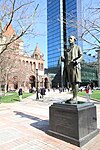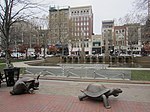Grundmann Studios
Grundmann Studios (1893–1917) in Boston, Massachusetts, was a building on Clarendon Street in the Back Bay. It contained artist's workspaces and multipurpose function rooms Copley Hall and Allston Hall. Prior to 1893, it functioned as a skating rink; after the Boston Art Students' Association leased the building it was renamed in honor of local art educator Emil Otto Grundmann. The Massachusetts Institute of Technology owned the property. Tenants included the Copley Society (formerly Boston Art Students' Association); artists Henry R. Blaney, Herman Dudley Murphy, Frank Richmond, Mary Bradish Titcomb; sculptor John A. Wilson, architect Josephine Wright Chapman; and the College Club. The structure existed until 1917, when it was demolished.
Excerpt from the Wikipedia article Grundmann Studios (License: CC BY-SA 3.0, Authors).Grundmann Studios
Clarendon Street, Boston Back Bay
Geographical coordinates (GPS) Address Nearby Places Show on map
Geographical coordinates (GPS)
| Latitude | Longitude |
|---|---|
| N 42.349425 ° | E -71.074611111111 ° |
Address
200 Clarendon
Clarendon Street 200
02116 Boston, Back Bay
Massachusetts, United States
Open on Google Maps









